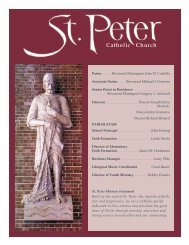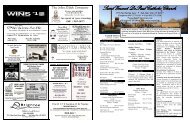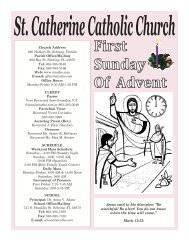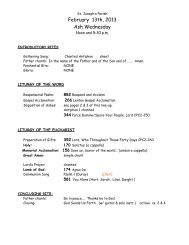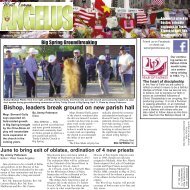The Perpetual Eucharistic Adoration Manual.pdf - Flocknote
The Perpetual Eucharistic Adoration Manual.pdf - Flocknote
The Perpetual Eucharistic Adoration Manual.pdf - Flocknote
You also want an ePaper? Increase the reach of your titles
YUMPU automatically turns print PDFs into web optimized ePapers that Google loves.
some retaliation since they surmised (as the narrator says) that Comgall was carrying his God. <strong>The</strong> saint was<br />
so moved by the experience that he exclaimed, "Lord, you are my strength, my refuge, and my Redeemer."<br />
As early as the Council of Nicea (325) we know that the Eucharist began to be reserved in the churches of<br />
monasteries and convents. Again, the immediate reason for this reservation was for the sick and the dying,<br />
and also for the ceremony of the fermentum. But naturally its sacred character was recognized and the place<br />
of reservation was set off from profane usage.<br />
From the beginning of community life, therefore, the Blessed Sacrament became an integral part of the<br />
church structure of a monastery. A bewildering variety of names was used to identify the place of<br />
reservation. Pastoforium, diakonikon, secretarium, prothesis are the most common. As far as we can tell,<br />
the Eucharist was originally kept in a special room, just off the sanctuary but separated from the church<br />
where Mass was offered.<br />
Certainly by the 800's, the Blessed Sacrament was kept within the monastic church itself, close to the altar.<br />
In fact, we have a poem from the year 802, telling of a pyx containing the Sacred Species reserved on the<br />
high altar of the abbey church at Lindisfarne in England.<br />
<strong>The</strong> practice of reserving the Eucharist in religious houses was so universal that there is no evidence to the<br />
contrary even before the year 1000. In fact, numerous regulations are extant which provided for protection<br />
of the sacred elements, as the wording went, "from profanation by mice and impious men." <strong>The</strong> species<br />
were to be kept under lock and key and sometimes in a receptacle raised high enough to be out of easy<br />
reach of profaning hands.<br />
It is interesting to note that one of the first unmistakable references to reserving the Blessed Sacrament is<br />
found in a life of St. Basil (who died in 379). Basil is said to have divided the <strong>Eucharistic</strong> Bread into three<br />
parts when he celebrated Mass in the monastery. One part he consumed, the second part he gave to the<br />
monks, and the third he placed in a golden dove suspended over the altar.<br />
This would suggest that, though we have less access to Oriental sources, the Eastern monasteries were<br />
centuries ahead of the West in reserving the <strong>Eucharistic</strong> elements in the monastic church proper and not<br />
only in a separate place.<br />
Among the treasures of Monte Cassino that seem to have been destroyed during the Second World War<br />
were two small ancient tabernacles, one of gold and the other of silver. <strong>The</strong>y were gifts of Pope Victor III<br />
(died 1087), who had been abbot at Cassino before his election to the papacy.<br />
4








